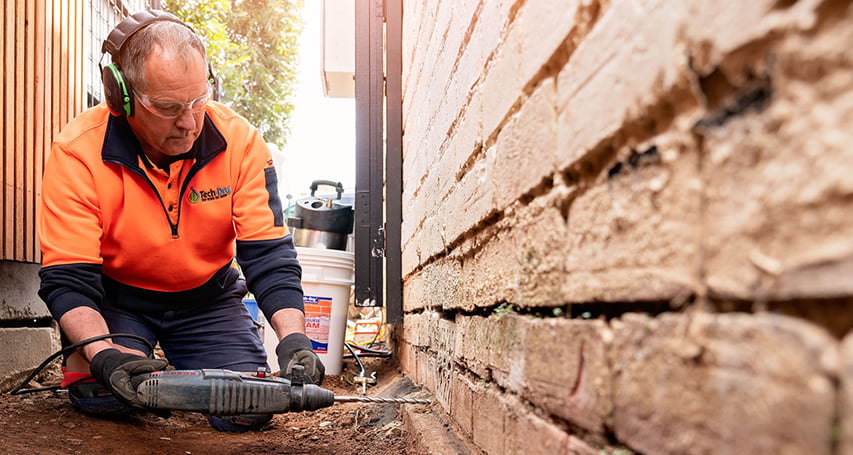
Welcome to our dedicated FAQ page, crafted to address your queries following the dampcoursing treatment at your property. At TechDry SA, we’re committed to not only providing top-tier solutions for salt damp but also ensuring you feel supported throughout the process.
This page aims to answer common questions, offer insights, and guide you post-treatment. It’s part of our commitment to customer satisfaction and enhancing your experience with us. For any additional information or personal assistance, don’t hesitate to reach out.
When will I receive my invoice?
You can expect an email with your invoice within the next 7-14 days. If there are specific details you’d like included or if you have questions about the billing process, please don’t hesitate to reach out.
What payment methods do you accept?
We accept Bank Transfer, OSKO, and credit cards (Mastercard, Visa, and American Express) to make the process as convenient for you as possible. Please note, we do not accept cash or cheque payments.
Is it safe to stay in my house after treatment?
Absolutely. The dampcoursing cream we use is non-toxic and water-based, ensuring your home remains safe for occupancy immediately after treatment
What should I do if my electrical switches trip?
Should any power points trip, please reset them from your meter box and monitor them for the next 24 hours. If issues persist, contact us at 81321166 for immediate assistance.

INJECTION HOLES:
I can’t see all the injection holes. Should I be concerned?
No need for concern. Injection holes may be concealed by skirting boards or drilled from one side only, as indicated on your diagram.
When will the outside injection holes be filled?
This information is outlined in your original quotation/diagram. If you need clarification or if it’s not mentioned, please contact our office.
There does not appear to be any cream in the holes:
The cream is designed to break down and form a barrier in your wall. It starts this process immediately, depending on the moisture content of your wall, and can occur quite quickly. So, it is normal for you to come home after the procedure, and there is nothing left to see in the holes.
Water from rain or sprinklers is getting in the holes – is this a problem?
Not at all. The holes are waterproof thanks to the cream, and therefore, any moisture will not penetrate.
DRY OUT PERIOD:
What is the dry-out period you refer to?
The dry-out period is simply the amount of time that your wall needs between the stages. The time needed will be indicated in months on your original quotation. This time is allowed so that any residual moisture and salts that are trapped within your wall have time to migrate towards the surface and either evaporate or position themselves in the outer layers of your plaster and/or mortar. Most of these residual salts are then removed during the follow-up stages.
How do I book follow-up repairs?
After processing your payment for the injection work, we’ll issue a receipt and suggest dates for the next stage. However, should you have specific scheduling needs, we recommend getting in contact ASAP to arrange suitable dates that suit your requirements.
Please note: Due to a temporary staffing shortage in our plastering department, there may be delays in scheduling any plastering/rendering repairs. We appreciate your patience as we navigate this situation.
Is it important to undertake the follow-up repairs?
Yes, if quoted, it is very important to undertake all aspects of the repair. The first stage that we have just completed creates a barrier to stop new moisture and salts from rising up into the base of your wall. However, this barrier does not get rid of the existing salts and moisture that are present in your wall and causing damage. The next steps that we have quoted are to assist that process.
Can we undertake these repairs ourselves?
Absolutely. If you know someone who has the specialised trades needed, by all means, get them to undertake the repairs. We just ask that you advise us in advance and also get the recommendations and specifications from us to ensure the repairs are undertaken correctly to give you the best result.
Can I paint or wallpaper over the treated areas immediately?
No, we recommend waiting. It is important that you wait for us to complete the quoted follow-up stages of work. If you redecorate now, you will need to paint over the affected area again once the repairs are undertaken.
Are there any special care instructions for the treated area during the dry-out period?
No. During this time, we recommend leaving the wall as is and allowing the process to occur as it should. However, if we have recommended any other strategies like attending to plumbing, leaks, or roof plumbing, this is the perfect time to address those issues as well.
Does the weather affect the drying process?
No, it doesn’t, but differing weather conditions can affect the way your wall may look during this time. During the dry-out period, existing salts trapped within the wall will migrate to the surface of the existing plaster. These salts are hygroscopic, meaning that they readily take up and retain moisture. When the weather is wet, the salts will attract that moisture, and therefore, the wall can look visibly wet. You may even see water droplets. This is very normal. This will not continue to happen once the wall has been replastered by us.
